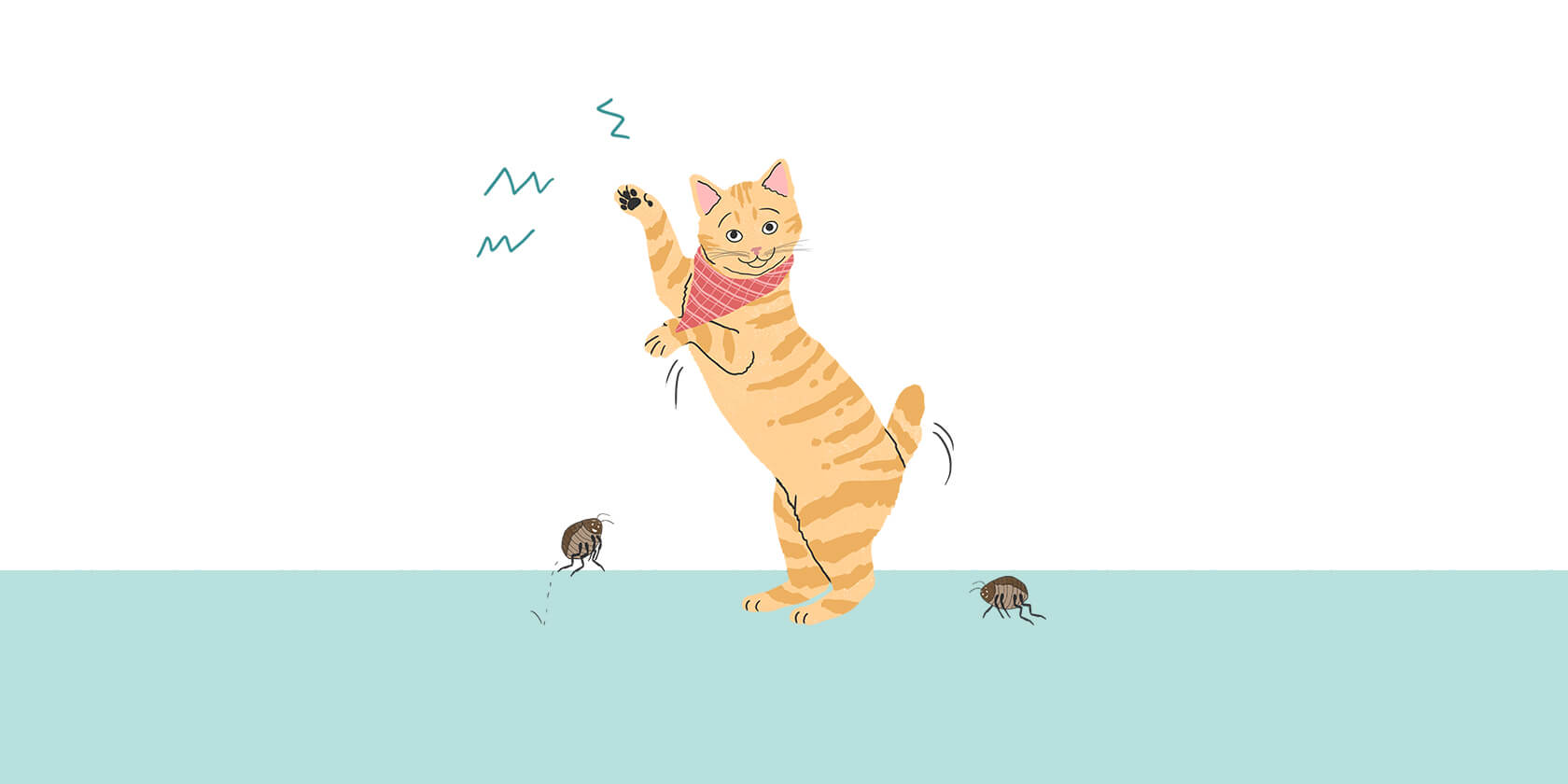As a cat owner, you may have had flea issues once or twice in your cat’s lifetime — and you’re not alone. Fleas are common parasites that affects cats, so you can rest assured that many cat owners have faced a similar struggle. But there may still be a lot you don’t know about fleas. Let’s explore some facts (and tips) to help you and your cat navigate the world of fleas.

- Fleas don’t fly. Fleas are wingless (and therefore flightless) insects. Fleas are also very thin and can navigate through cat’s hair with ease.
- Fleas can jump 6 inches straight up. Although small in stature, adult fleas are still capable of jumping approximately 6 inches vertically[1]. Whether your cat is walking outside, hanging out in your home, or visiting the kennel or groomer, all the flea has to do is jump on for a ride as the cat passes by. Cats can also be infested by exposure to other pets, stray animals, pet sitters and wildlife as the flea leaps from one to another.
- Fleas lay lots of eggs. It only takes one flea to cause an infestation. That’s because a single female adult flea can lay up to 50 eggs in one day[2].
- Fleas can drink 15 times their body weight in blood each day[3]. Adult fleas are voracious blood-feeders, meaning they use the infested cat’s blood as their food source. This can cause the cat to become anemic (low red blood cell volume). Since red blood cells carry oxygen around the body, blood loss means decreased oxygen to their muscles and major organs such as the brain and heart. For these reasons, anemia may result in weakness and even death in extreme circumstances.
- Fleas can cause itching. Fleas affect cats in several ways, and every cat is different. Often the first symptom to be recognized by cat owners is excessive itching, biting, or scratching. Fleas jumping and moving around on the cat’s hair and skin cause irritation. As a result, you may see patches of hair loss or redness from scratching, which may become more evident as more hair is lost[4].
- A single flea can cause flea allergy dermatitis. In some cats, it only takes one flea to cause a severe allergy known as flea allergy dermatitis, which can result in severe itching and scratching, hair loss, and redness[4].
- Fleas can spread disease and parasites. Fleas can transmit bacterial diseases such as rickettsia, mycoplasma, tularemia, and bartonella. They can also transmit parasites when feeding from cats or if swallowed, including intestinal parasites like tapeworms.
- Check your cat’s belly for fleas. Live, adult fleas are visible. Typically, they are best seen on less-haired areas of a cat’s body, such as their stomach, where you may see the brown/black fleas jumping quickly through your cat’s hair. Additionally, “flea dirt” may be detected when closely examining your cat’s coat. It’s essentially a flea’s fecal matter after digesting their blood meal. It appears as brown pepper-like specs in the fur.
- Flea eggs can land anywhere and everywhere. Here’s one last unsettling fact about fleas. Once a female flea lays her eggs, they almost immediately fall off onto carpeting, furniture, beneath cushions, or between cracks in wood flooring, as well as wherever your cat sleeps or rests. Therefore, a comprehensive flea-control plan is essential and needs to include treating both your cat and their environment to eliminate current infestations and prevent subsequent re-infestation.
The elimination of adult fleas on your cat should include the use of a flea preventative. Combining your cat’s flea preventative with environmental decontamination is vital for getting rid of fleas. This includes vacuuming and washing bedding, cushions, couch covers, and everywhere your cat hangs out. Thorough vacuuming removes many of the eggs, larvae, and pupae developing within your home. Don’t forget to vacuum along the edges of rooms and beneath furniture, cushions, beds, and rugs. But be aware! Vacuuming will cause flea eggs to hatch, crawl back out of your vacuum, and essentially undo all your hard work. So, seal the vacuum bag in a garbage bag immediately and discard it in an outdoor trash container.
Although the fight against fleas sounds frightening, don’t be intimidated. Fleas have been successfully treated for many years. As long as you arm yourself with knowledge and your veterinarian’s advice, your cat and your home can be protected.
ZPC-01493
IMPORTANT SAFETY INFORMATION: See Prescribing Information. The safe use of Revolution Plus has not been established in kittens less than 8 weeks old or in breeding, pregnant or lactating cats. Reported side effects in clinical trials included lethargy and anorexia. Use with caution in cats with a history of neurologic disorders. Revolution Plus contains sarolaner, a member of the isoxazoline class, which has been associated with neurologic adverse reactions, such as tremors, ataxia, and seizures in cats with or without a history of neurologic disorders. In humans, Revolution Plus may be irritating to skin and eyes.
Revolution Plus is a simple-to-apply, quick-drying, small-volume, monthly topical solution that protects against fleas (Ctenocephalides felis), ticks (lone star tick [Amblyomma americanum], black-legged or deer tick [Ixodes scapularis], Gulf Coast tick [Amblyomma maculatum] and American dog tick [Dermacentor variabilis]), ear mites (Otodectes cynotis), roundworms (Toxocara cati), hookworms (Ancylostoma tubaeforme), and heartworms (Dirofilaria immitis) for cats and kittens as young as 8 weeks of age and weighing 2.8 pounds or greater.
- Rust MK. The Biology and Ecology of Cat Fleas and Advancements in Their Pest Management: A Review. Insects. 2017; 8(4):118.
- Fleas — Cat. Companion Animal Parasite Council. https://www.capcvet.org/guidelines/fleas/. Accessed August 10, 2021.
- Dryden, M. W., & Gaafar, S. M. (1991). Blood consumption by the cat flea, Ctenocephalides felis (Siphonaptera: Pulicidae). Journal of medical entomology, 28(3), 394–400.
- Cat Owners — Fleas. Companion Animal Parasite Council. Available at: http://www.petsandparasites.org/cat-owners/fleas. Accessed August 10, 2021.







